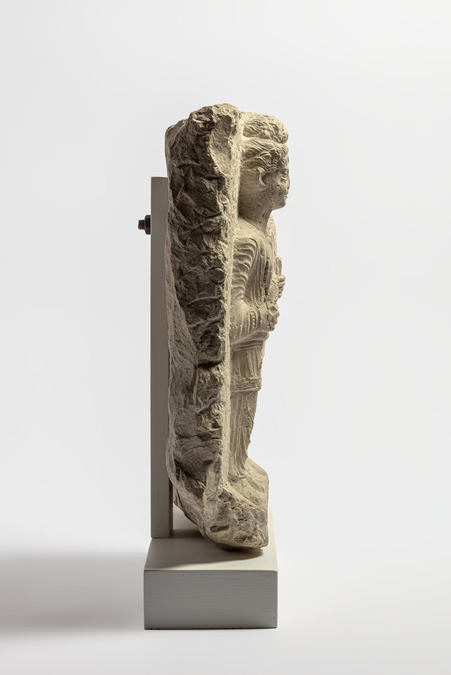Palmyrene loculus stele depicting two standing boys, Philinos and Taimaḥâ
Summary
Two boys are depicted on a grave stele. Both of their names are attested, the left figure as Philinos and the right as Taimaḥâ. The overall object is well preserved with slightly fragmented frame, especially in the upper right and lower left corner. The portrait to the left is well-preserved: his cheeks and neck are slightly weathered, and on the upper part of his tunic, on his chest, a few pieces are missing. A large diagonal crack is visible just below his left shoulder. The portrait to the right is less well-preserved: a large area of his face is missing and a large crack by the left shoulder and across the chest is visible. In the background, a four-lined inscription is rendered and placed in the upper right corner of the background and a second inscription is indicated between the heads of the two boys.
The boys are standing hand in hand, wearing almost matching clothing in the so-called ‘Parthian Style’. The boy to the left is holding a bird in front of his chest. The boy to the left is holding a bunch of grapes and another object, perhaps a book-roll.
Description of object
Two boys, Philînos and Taimaḥâ, are depicted standing frontally hand in hand on a framed stele with a projecting plinth. The object is well preserved with slightly fragmented frame, especially in the upper right and lower left corner. The portrait to the left is well-preserved: his cheeks and neck are slightly weathered, and on the upper part of his tunic, on his chest, a few pieces are missing. A large diagonal crack is visible just below his left shoulder. The portrait to the right is less well-preserved: a large area of his face is missing and a large crack by the left shoulder and across the chest is visible. In the background, a four-lined inscription is rendered and placed in the upper right corner of the background and a second inscription is indicated between the heads of the two boys.
The boy to the left, Philînos, is standing with the weight resting on his left leg. He has short, wavy hair indicated by grooves, with the locks arranged in horizontal rows, looking tidier than his brother’s. The eyebrows are indicated by wide grooves, his eyes are large and iris and pupils are indicated by incised circles. The nose is wide and the ears are protruding with indication of helix and earlobes. His mouth is narrow and the chin is wide. Philînos’ arms are under proportioned. His right arm is flexed and held horizontally in front of the torso, where he is holding a bird with his right hand. All fingers are extended. The left arm is extended, with his left hand holding on to his brother, Taimaḥâ. Philînos is wearing clothing in the so-called ‘Parthian style’. The belted, long-sleeved tunic has a rounded neckline. Beaded bands are running along the cuff of the sleeves and neckline and a double row is running centrally on the tunic with a wavy pattern between them. He is wearing trousers, which are decorated by a floral pattern and over-trousers decorated by beaded bands. On his hip, a band belt, is composed of two plain bands knotted at the centre, with the ends looping underneath one another on either side. A wide decorated band, details of which are unclear, extends downwards along the middle of the trouser legs. Philînos is also wearing shoes.
Taimaḥâ is slightly taller than his brother, Philînos. Taimaḥâ is depicted frontally, in full portrait figure. He has short, wavy hair arranged in rich locks indicated by grooves and ridges, that give his hair an almost tousled appearance. His face is oval in shape. His eyebrows are indicated by wide grooves and the eyes are almond-shaped, with iris and pupils indicated by concentric, incised circles. His ears are slightly protruding with indication of helix and earlobes. The arms, however, are under proportioned. His right arm is extended and he is holding a large bunch of grapes with his right hand. The left arm is flexed and held horizontally in front of the torso. With his left hand, he is holding a wide rectangular object, perhaps a book-roll. Taimaḥâ is also wearing shoes and the so-called ‘Parthian dress’ in the same manner as his brother: notably tunic, trousers, and over-trousers. Overall, it appears that the smaller of the two brothers appears to be out of proportion in comparison to his brother. His stance is also similar; note the slight emphasis of weight being placed on the left leg, shown through a slight bend just above the torso.
(Upper right corner) TYMḤʾ | BR WHBLT | BR TYMʾ | ḤBL
Taimaḥâ, son of Wahballât, son of Taimê. Alas!
(Between their heads) PLNS | ʾHWHY | ḤBL
Philînos, his brother. Alas!
CIS: 4369 PAT: 0727
Choice of methods
Visual examination
- Macroscopic
Bibliography
Ingholt Archive
H. Ingholt (1928), Studier over Palmyrensk Skulptur, København, 152, PS 514.
H. Ingholt (1935), Five Dated Tombs from Palmyra, Berytus II, 69, pl. XXX,1.
F.O. Hvidberg-Hansen & G. Ploug (1993), Palmyra Samlingen, Ny Carlsberg Glyptotek, København, 88, no. 46.
M.A.R. Colledge (1976), The Art of Palmyra, London, 244.F. Pierson (1984), Reserches sur le costume des enfants dans l’iconographie palmyrénienne, in Revue des Archéologues et historiens d’art de Louvain, 93, fig. 6.
- IN 2776
- Stele
- c. 150 C.E.
- Roman Imperial
- Limestone
- Acquired in 1929 from Dr. Ziadé in Beirut by Harald Ingholt.
- (Left figure) H: 38.5 cm.; W: 20 cm.; D: 6 cm. (Right figure) H: 43 cm.; W: 20.5 cm.; D: 6 cm.



